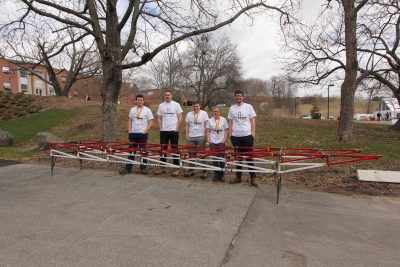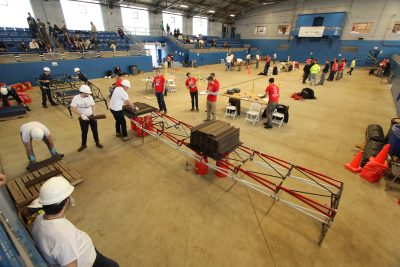Steel Bridge Competitions Offer Experiential Learning Opportunity That Prepare Students for Industry
Author: Engineering Alumni Office
Posted on Sep 15, 2017
Category: Student Spotlight
For only the second year, UNB Engineering students are studying and training to compete in the American Society of Civil Engineering (ASCE) National Student Steel Bridge Competition and The Canadian National Steel Bridge Competition (CNSBC) in 2018. The competitions challenge student teams to design, fabricate, and construct a 1:20 scale model steel bridge, spanning a 6-foot “river”, as quickly and efficiently as possible.
The bridge must support 2,500 pounds without deflecting more than three inches. Teams are judged on construction technique, construction time, lightness, aesthetics, stiffness, economy and structural efficiency. The Steel Bridge Competitions are a tremendous experiential learning opportunity for civil engineering students as they provide the opportunity to exercise valuable skills: applying real-world engineering principles; gaining hands-on knowledge of the design and fabrication process; networking; and competing against other teams. These future engineers have the chance to practice solving common engineering issues related to project management, cost, safety, aesthetics, special constraints, material properties, and serviceability.

2017 Steel Bridge Competition team members Taylor Quinlan, Mathew MacEachern, Alex Berry, Michelle Stetson, Patrick Blanchard
The Spring of 2017 was the first time that UNB sent a team of students to the competitions, and given the steep learning curve, they did well, placing a respectable 5th in the Regionals (US Northeast and Eastern Canada) and an overall of 73rd out of 251 schools that competed in North America.
The team's success relative to their experience was partly due to a new course offered in the Fall semester – Design and Optimization of Steel Bridges - that preps and mentors the team. The course is a senior year credited elective, and students must have already completed pre-requisites in structural engineering, structural steel, and design.
Dr. Alan Lloyd began the class as a way to enhance the learning experience for structural engineering students, and to prepare them to be able to compete at a high level against other schools. By the end of the course, they’ll have completed a design of the bridge and optimized the process for building it (the bridge must be brought in small pieces to the competitions and put together in a timed construction process). The students will have produced scaled and full-sized drawings plus a detailed design report with calculations on all members, costs and connections, which they’ll present to a public audience of interested faculty, students, alumni and professionals. In the second semester that begins in January, the students work on their own time in UNB lab space to fabricate the bridge parts according to their design. First rounds of the competitions begin in April/May.

“The Steel Bridge Competitions provide students with a design and management experience similar to what they will experience in industry, as well as the opportunity to learn fabrication processes, and the excitement of competing against teams,” Lloyd affirms. “As we build more funding to support students traveling to these competitions, and as we build more institutional knowledge of best practices for them, more and more of our students will be able to not only participate but to win.” That’s what the team this year is looking to get closer to, with a goal of placing in the top two at regionals and moving on to the national competition. “It’s above and beyond classroom learning and takes dedication on the part of our students, but it’s a great way to bridge senior year and entering the workforce.”
For more information on the competition, including how to sponsor the team, visit their website.
